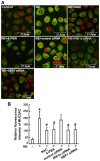Endoplasmic reticulum stress/XBP1 promotes airway mucin secretion under the influence of neutrophil elastase
- PMID: 33760106
- PMCID: PMC7979262
- DOI: 10.3892/ijmm.2021.4914
Endoplasmic reticulum stress/XBP1 promotes airway mucin secretion under the influence of neutrophil elastase
Abstract
Endoplasmic reticulum (ER) stress is an important reaction of airway epithelial cells in response to various stimuli, and may also be involved in the mucin secretion process. In the present study, the effect of ER stress on neutrophil elastase (NE)‑induced mucin (MUC)5AC production in human airway epithelial cells was explored. 16HBE14o‑airway epithelial cells were cultured and pre‑treated with the reactive oxygen species (ROS) inhibitor, N‑acetylcysteine (NAC), or the ER stress chemical inhibitor, 4‑phenylbutyric acid (4‑PBA), or the cells were transfected with inositol‑requiring kinase 1α (IRE1α) small interfering RNA (siRNA) or X‑box‑binding protein 1 (XBP1) siRNA, respectively, and subsequently incubated with NE. The results obtained revealed that NE increased ROS production in the 16HBE14o‑cells, with marked increases in the levels of ER stress‑associated proteins, such as glucose‑regulated protein 78 (GRP78), activating transcription factor 6 (ATF6), phosphorylated protein kinase R‑like endoplasmic reticulum kinase (pPERK) and phosphorylated (p)IRE1α. The protein and mRNA levels of spliced XBP1 were also increased, and the level of MUC5AC protein was notably increased. The ROS scavenger NAC and ER stress inhibitor 4‑PBA were found to reduce ER stress‑associated protein expression and MUC5AC production and secretion. Further analyses revealed that MUC5AC secretion was also attenuated by IRE1α and XBP1 siRNAs, accompanied by a decreased mRNA expression of spliced XBP1. Taken together, these results demonstrate that NE induces ER stress by promoting ROS production in 16HBE14o‑airway epithelial cells, leading to increases in MUC5AC protein production and secretion via the IRE1α and XBP1 signaling pathways.
Keywords: endoplasmic reticulum stress; mucin 5AC; reactive oxygen species; inositol‑requiring kinase 1α; X‑box‑binding protein 1; respiratory inflammation.
Conflict of interest statement
The authors declare that they have no competing interests.
Figures







Similar articles
-
Fine particulate matter promotes airway inflammation and mucin production by activating endoplasmic reticulum stress and the IRE1α/NOD1/NF‑κB pathway.Int J Mol Med. 2023 Oct;52(4):96. doi: 10.3892/ijmm.2023.5299. Epub 2023 Sep 1. Int J Mol Med. 2023. PMID: 37654182 Free PMC article.
-
Mechanism of the induction of endoplasmic reticulum stress by the anti-cancer agent, di-2-pyridylketone 4,4-dimethyl-3-thiosemicarbazone (Dp44mT): Activation of PERK/eIF2α, IRE1α, ATF6 and calmodulin kinase.Biochem Pharmacol. 2016 Jun 1;109:27-47. doi: 10.1016/j.bcp.2016.04.001. Epub 2016 Apr 6. Biochem Pharmacol. 2016. PMID: 27059255
-
TNFα selectively activates the IRE1α/XBP1 endoplasmic reticulum stress pathway in human airway smooth muscle cells.Am J Physiol Lung Cell Mol Physiol. 2020 Mar 1;318(3):L483-L493. doi: 10.1152/ajplung.00212.2019. Epub 2020 Jan 15. Am J Physiol Lung Cell Mol Physiol. 2020. PMID: 31940218 Free PMC article.
-
Molecular signal networks and regulating mechanisms of the unfolded protein response.J Zhejiang Univ Sci B. 2017 Jan.;18(1):1-14. doi: 10.1631/jzus.B1600043. J Zhejiang Univ Sci B. 2017. PMID: 28070992 Free PMC article. Review.
-
Emerging roles for the ER stress sensor IRE1α in metabolic regulation and disease.J Biol Chem. 2019 Dec 6;294(49):18726-18741. doi: 10.1074/jbc.REV119.007036. Epub 2019 Oct 30. J Biol Chem. 2019. PMID: 31666338 Free PMC article. Review.
Cited by
-
Fine particulate matter promotes airway inflammation and mucin production by activating endoplasmic reticulum stress and the IRE1α/NOD1/NF‑κB pathway.Int J Mol Med. 2023 Oct;52(4):96. doi: 10.3892/ijmm.2023.5299. Epub 2023 Sep 1. Int J Mol Med. 2023. PMID: 37654182 Free PMC article.
-
Research progress and advances in endoplasmic reticulum stress regulation of acute kidney injury.Ren Fail. 2024 Dec;46(2):2433160. doi: 10.1080/0886022X.2024.2433160. Epub 2024 Nov 25. Ren Fail. 2024. PMID: 39586579 Free PMC article. Review.
-
Endoplasmic Reticulum Stress of Gut Enterocyte and Intestinal Diseases.Front Mol Biosci. 2022 Mar 24;9:817392. doi: 10.3389/fmolb.2022.817392. eCollection 2022. Front Mol Biosci. 2022. PMID: 35402506 Free PMC article. Review.
-
Novel neutrophil extracellular trap-related mechanisms in diabetic wounds inspire a promising treatment strategy with hypoxia-challenged small extracellular vesicles.Bioact Mater. 2023 Apr 14;27:257-270. doi: 10.1016/j.bioactmat.2023.04.007. eCollection 2023 Sep. Bioact Mater. 2023. PMID: 37122894 Free PMC article.
-
XBP1 Regulates the Transcription of HIF-1a in BALB/c Mice with Chronic Rhinosinusitis without Polyps.Anal Cell Pathol (Amst). 2022 Jul 23;2022:3066456. doi: 10.1155/2022/3066456. eCollection 2022. Anal Cell Pathol (Amst). 2022. PMID: 35915851 Free PMC article.
References
MeSH terms
Substances
LinkOut - more resources
Full Text Sources
Other Literature Sources
Research Materials
Miscellaneous

